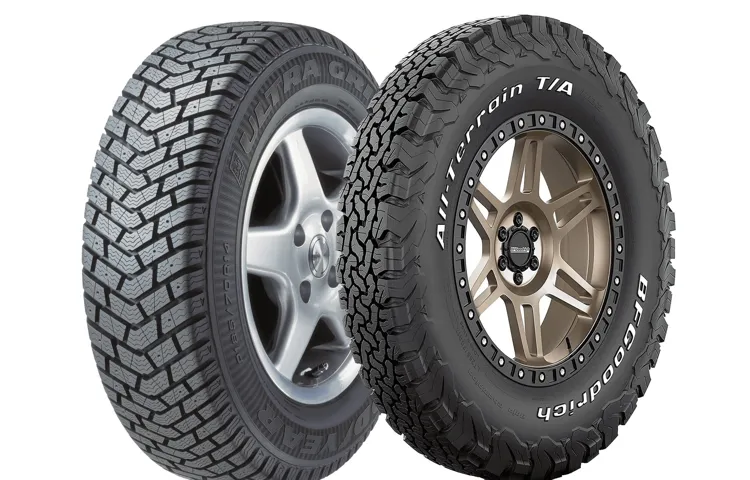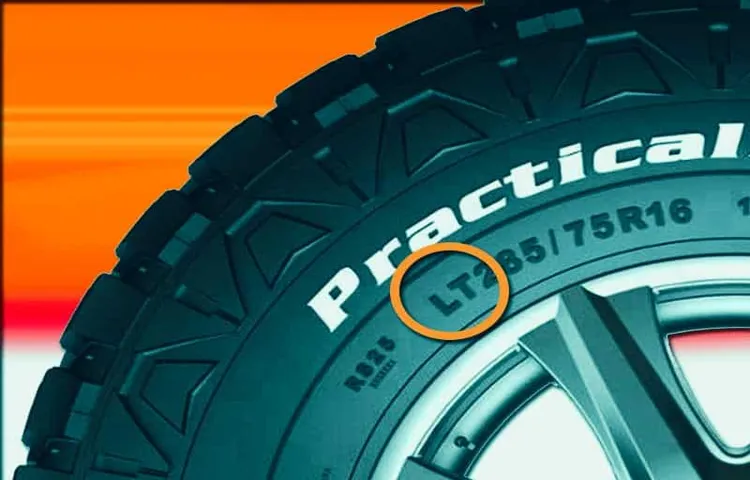If you’re shopping for new tires, you’ve probably noticed a bewildering array of letters, numbers, and symbols on the sidewall of your current tires. One of the most commonly seen letter combinations is “LT.” So, what does LT mean on tire size? LT stands for “Light Truck,” and it’s used to indicate that a tire is suitable for use on a light truck or SUV.
As the name implies, LT tires are designed to handle the heavier loads that these vehicles commonly carry, providing improved stability and durability compared to a standard passenger car tire. But isn’t it confusing to see a letter combination and have no clue what it means? By learning about LT tires, you’ll be prepared to make an informed decision when it comes time to buy new tires for your truck or SUV. So, let’s take a closer look at what sets LT tires apart from other types of tires, and why they may be the right choice for your vehicle.
Table of Contents
Understanding Tire Size Basics
LT stands for “Light Truck” and is indicated in the tire size to imply the intended purpose of the tire to be used on light trucks. This means that the LT tire size differs from the regular Passenger car tire size with the added capability to bear the truck’s weight and carry heavier loads. Essentially, tire sizes are complex and detailed combinations of letters, numbers, and symbols that indicate the tire’s dimensions, load index, and speed rating.
The tire width, aspect ratio, and wheel diameter are all part of the tire size code and are important aspects to consider when choosing the right tire for your vehicle. Understanding the basics of tire size is essential to find the perfect tire for your vehicle that will ultimately optimize its performance, stability, and safety on the road.
Breaking Down Tire Size Numbers
If you’re looking to buy new tires or trying to understand what size tires to get, the string of numbers and letters on the tire’s sidewall can be overwhelming. However, breaking down tire size numbers can be simple once you understand the basics. There are three main components to a tire size: width, aspect ratio, and rim diameter.
The first number in a tire size represents its width, which is measured in millimeters from sidewall to sidewall. The second number, known as the aspect ratio, is the tire’s height from tread to rim and is expressed as a percentage of the width. Lastly, the rim diameter is the measurement of the wheel’s diameter in inches.
By understanding these three numbers, you can determine whether a tire will fit your vehicle and provide the performance you need. For example, a tire size of 205/55R16 means that the tire’s width is 205mm, the aspect ratio is 55% of the width, and the rim diameter is 16 inches. Understanding tire size basics helps you make the right decision in purchasing tires for your vehicle.

Understanding the Importance of a Tire’s Load Rating
Understanding Tire Size Basics When it comes to buying tires, one of the most important things to understand is tire size. The size of a tire is marked on the sidewall, and it consists of a series of numbers and letters. For instance, a common tire size is P215/65R1
The first letter indicates the type of tire – in this case, a passenger car tire. The three-digit number following that refers to the width of the tire in millimeters. The second number is the aspect ratio, or the ratio of the tire’s height to its width.
The “R” in the size indicates that the tire has radial construction, and the last number is the diameter of the wheel in inches. Understanding tire size is essential when it comes to buying the right replacement tires for your vehicle. It ensures that you get the proper fit and performance for your car.
Additionally, it’s important to consider the load rating of the tire. The load rating refers to the amount of weight the tire can safely carry. This is typically indicated by a number on the tire’s sidewall.
It’s crucial to choose a tire that can handle the weight of your car and any additional cargo it may carry. By understanding tire size basics and load ratings, you can make an informed and safe tire purchase for your vehicle.
Choosing the Right Tires for Your Vehicle
Have you ever wondered what the “LT” means on a tire size? Well, “LT” stands for Light Truck and it indicates that the tire is designed for use on light trucks, SUVs, and vans. These tires are built with stronger materials and thicker sidewalls to handle the weight and demands of these types of vehicles. If you have a light truck or SUV, it’s important to choose tires that are specifically designed for these vehicles in order to ensure proper handling, performance, and safety.
It’s also important to choose the right size of tire for your vehicle, which can be found on the sidewall of your current tires or in your vehicle’s owner’s manual. By selecting the right tires for your vehicle, you can ensure optimal performance and safety on the road.
Considering Your Driving Needs
When it comes to choosing the right tires for your vehicle, there are several factors to consider. One of the most important is your driving needs. Are you a city driver, primarily using your vehicle for commuting and errands? Or do you frequently take road trips or drive in off-road conditions? Tire manufacturers offer a range of tire options that cater to different driving needs, such as all-season tires, winter tires, and performance tires.
It’s important to assess your driving habits and choose a tire that will offer the best performance and safety for your specific needs. Additionally, consider the climate in your area and the type of terrain you will be driving on. Taking the time to choose the right tire can make a big difference in your driving experience and safety on the road.
So, think about your driving needs and choose wisely!
Consulting Your Vehicle’s Manual and Tire Label
When it comes to choosing the right tires for your vehicle, it’s important to consult both your vehicle’s manual and tire label. Your manual will provide you with specific recommendations and requirements, such as the correct tire size, load capacity, and speed rating. These requirements should not be ignored, as they are crucial for both your safety and the performance of your vehicle.
Your tire label, on the other hand, will provide you with additional information such as the tire type, maximum tire pressure, and recommended tire rotation pattern. It’s important to take all of these factors into consideration when selecting new tires for your vehicle. Don’t forget to also consider the type of driving you will be doing and the climate you will be driving in.
This will ensure that you choose the right tire that will provide optimal performance and safety for your vehicle.
Conclusion
And so, we come to the end of our journey trying to decipher the mysterious code of tire sizes and what LT actually means. Much like any puzzle, it seems daunting at first, yet with a little bit of research and understanding, we can unravel the mystery. LT, as we now know, stands for Light Truck, indicating that the tire is specifically designed for commercial vans, SUVs and pickup trucks.
Now, armed with this knowledge, we can confidently make informed decisions when it comes to purchasing tires and keep our vehicles rolling smoothly on the roads.”
FAQs
What does the “LT” mean in tire size?
The “LT” in tire size stands for “Light Truck”, indicating that the tire is designed for use on light trucks, SUVs, and other vehicles designed for load-carrying purposes.
What is the difference between an LT tire and a passenger tire?
LT (Light Truck) tires are designed for use on pickups, SUVs, and other light duty trucks. They are built with stronger sidewalls to carry heavier loads and are generally more durable than passenger tires, which are designed for use on cars and minivans.
Can I use LT tires on my passenger car?
While LT tires can be used on passenger cars, they are not recommended. LT tires are designed specifically for larger, heavier vehicles and are often stiffer and less comfortable than passenger car tires.
How do I know if I need LT tires on my truck?
If you have a light truck or SUV and regularly carry heavy loads or tow trailers, you may benefit from using LT tires. You can also consult your vehicle owner’s manual or a tire professional to determine if LT tires are recommended for your specific vehicle.
Can I use passenger tires on my light truck?
While you can technically use passenger tires on a light truck or SUV, it is generally not recommended. Passenger tires are not built to handle the heavier loads and stress that these vehicles can put on them, and can wear out more quickly or even fail.
Do all tire manufacturers make LT tires?
No, not all tire manufacturers make LT tires. Some tire brands specialize in making tires for light trucks and SUVs, while others focus more on passenger car tires.
How do I determine the correct LT tire size for my vehicle?
The correct LT tire size for your vehicle can often be found in your vehicle owner’s manual or on the tire information placard located on the driver’s side doorjamb. You can also consult a tire professional to determine the correct size for your specific vehicle.


